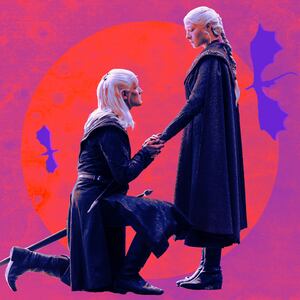Vhagar is Westeros’ largest and most formidable dragon, instrumental in Aegon Targaryen’s conquest of the continent in 2 BC, the last living creature from that era.
She’s named after a Valyrian God. She's fought more than a 100 battles. Her fire breath can melt armor. Her roar can shake the foundations of Storm’s End. None of this matters on this internet, where you can find House of the Dragon viewers calling her everything from “Walmart-brand Godzilla” to “a hag” to “grandma”. And they don’t mean that last one affectionately.
There’s no shortage of irksome men in House of the Dragon to root agains—the slimy, ingratiating Larys Strong (Matthew Needham), the hypocritical, upwards-failing Criston Cole (Fabien Frankel), actual rapist Aegon Targaryen (Tom Glynn-Carney)—which makes all this vitriol for an ancient flying lizard even more amusing. Scroll through Twitter after an episode airs, however, and you’ll find variations of:
It’s easy enough to trace the source of Vhagar hate.
House of the Dragon, in shying away from depicting its characters as too villainous, has deviated from its source material by painting them as victims of circumstances beyond their control.
The Aemond Targaryen of Fire & Blood pursues his young nephew Lucerys Velaryon on dragonback, seeking vengeance for a childhood slight, an encounter that ends with the young boy and his dragon, Arrax, dead. George R.R. Martin’s book describes the day as being “as black as [Aemond’s] heart”, underlining his actions as deliberate.

Vhagar and Aemond.
HBOIn the show, Aemond (Ewan Mitchell) still sets off after Lucerys (Elliot Grihault) in Season 1—a terrifying sequence staged amid the howling wind, pouring rain, and pervasive darkness of Storm’s End—but attempts to pull back at the last moment. Disregarding her rider’s screams and protests, however, Vhagar looms up on Lucerys and Arrax, then chomps them clean in half. Intent becomes accident. By framing one of the book’s most cold-blooded murders as an oopsie, the show deflects blame away from Aemond…and right onto his dragon.
Vhagar wasn’t always a House of the Dragon villain. The first visual associated with her is one of pure joy, her previous rider Laena Velaryon (Nanna Blondell) grinning with delight as she races Daemon Targaryen (Matt Smith) across the skies on dragonback.
When Laena shouts, “Dracarys”, the Valyrian command to burn, it’s a playful bit of fun instead of a battle cry meant to rain death and destruction. The next time Laena uses it, she’s dying of childbirth-induced complications and pleads with Vhagar to set her on fire so that she can claim a dragonrider’s death instead. Laena has to cry out several times before Vhagar finally listens.
It’s a detail that humanizes the dragon, her initial refusal to obey stemming from her anguish at what is being asked of her. The horrific nature of Lucerys’ killing, however, turned Vhagar into a character fans love to hate. And the dragon’s involvement in the death of beloved character Rhaenys Targaryen (Eve Best) in Season 2 only cemented it.
For every shot that depicts Vhagar’s fearsomeness—a split-second of lightning at Storm’s End illuminates how tragically dwarfed and outmatched Arrax is—there are scenes that emphasize her age and weariness. Her wings are full of holes. She takes to the sky with a lumbering effort, rather than gliding across it like the show’s younger, more agile dragons. She spends most of her time asleep, and when Aemond delays his attack on Rhaenys, Vhagar sinks back heavily onto the forest floor with a thud.
By the end of Season 2, it’s far easier to see the dragon as a geriatric pet, rather than a terrifying, fire-breathing nuclear weapon. Her size, once a metric of terror, is now a liability. Her advanced age has prompted a fandom in-joke that she’s probably experiencing a form of dragon dementia, mistaking Aemond for her very first rider, Visenya Targaryen, and believing that she’s still fighting in the First Dornish War. Even House of the Dragon sound designer Paula Fairfield thinks Vhagar has Irritable Bowel Syndrome.
If dragons are revered in Westeros, this season of House of the Dragon has pointed out that even Gods can be felled. The Greens parading Meleys’ severed head through the streets in Episode 4 is meant as a show of strength, but is really a grave tactical error, revealing to the smallfolk that even their fears have real flesh-and-blood vulnerabilities. “I thought dragons were gods,” says a bystander at the sight. “It’s just meat,” says another.
In Episode 7, Rhaenyra Targaryen’s (Emma D’Arcy) plan to have Targaryen bastards bond with the Blacks’ unclaimed dragons is met with outrage from the dragonkeepers, who accuse her of reducing these ancient creatures to “playthings for the games of men”.
They’d probably have a fit if they knew of Twitter, where edits of Mean Girls (2004) envision Vhagar as Regina George and there’s criticism of the 180-year-old dragon’s appearance, her wattle and lack of horns (yet another unrealistic beauty standard for women). As Westeros descends into an all-out civil war, however, it’s still Vhagar who remains the realm’s most intimidating weapon. Let her have a little war crime, as a treat.







